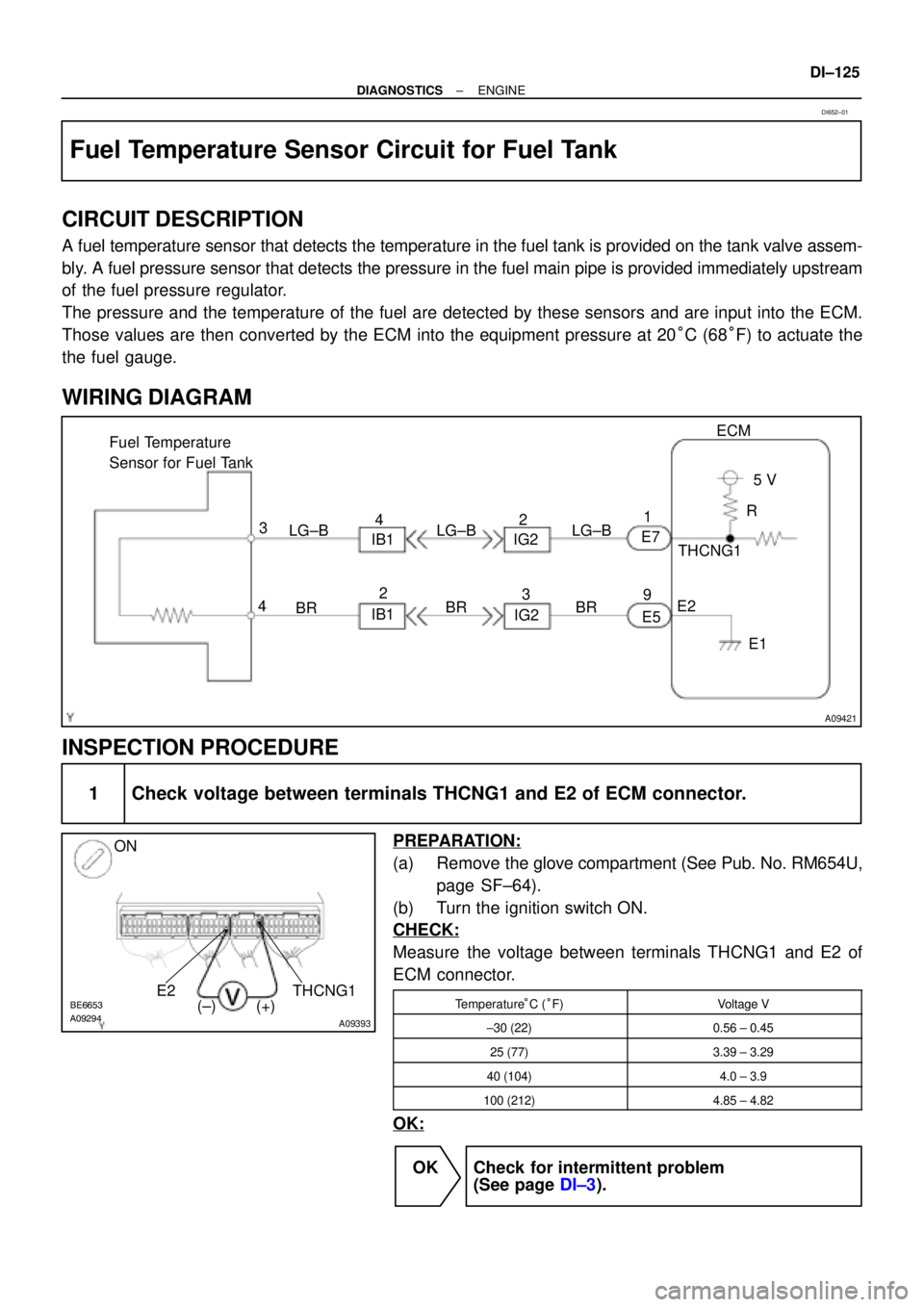Page 2275 of 4592
A00309
ECM Fuel Pressure Sensor
for Fuel Pipe
1PCNG1VC
E2 Y
G±RE5
E7
E5 3
25 V
E1 1
5
9
BR
BE6653A03008A09254
ON
E2VC
(±) (+)
± DIAGNOSTICSENGINE
DI±123
Fuel Pressure Sensor Circuit for Fuel Pipe
CIRCUIT DESCRIPTION
Refer to DTC P0190 on page DI±56.
WIRING DIAGRAM
INSPECTION PROCEDURE
1 Check voltage between terminals VC and E2 of ECM connector.
PREPARATION:
(a) Remove the glove compartment (See Pub. No. RM654U,
page SF±64).
(b) Turn the ignition switch ON.
CHECK:
Measure the voltage between terminals VC and E2 of the ECM
connector.
OK:
Voltage: 4.5 ± 5.5 V
NG Check and replace ECM (See page IN±29).
OK
DI650±01
Page 2276 of 4592
BE6653A09292A09419
E2 ONPCNG1
(±)
(+)
DI±124
± DIAGNOSTICSENGINE
2 Check voltage between terminals PCNG1 and E2 of ECM connector.
PREPARATION:
(a) Remove the glove compartment (See Pub. No. RM654U,
page SF±64).
(b) Turn the ignition switch ON.
CHECK:
Measure the voltage between terminals PCNG1 and E2 of the
ECM connector.
OK:
Needle position of fuel level gaugeVoltage (V) at 20°C (68°F)
4/43.3
3/42.7
2/42.0
1/41.3
OK Check and replace ECM (See page IN±29).
NG
3 Check for open and short in harness and connector between fuel pressure sen-
sor for fuel pipe and ECM
(See page IN±29).
NG Repair or replace harness or connector.
OK
Replace fuel pressure sensor for fuel pipe
(See page SF±46).
Page 2277 of 4592

A09421
E7
E51
9ECM
5 V
THCNG1
E2
E1 R
BR 3
4
BR Fuel Temperature
Sensor for Fuel Tank
BR IB1
IG2 LG±B
IB1IG2 LG±B LG±B 42
3 2
A09294BE6653
A09393
ON
THCNG1 E2
(±) (+)
± DIAGNOSTICSENGINE
DI±125
Fuel Temperature Sensor Circuit for Fuel Tank
CIRCUIT DESCRIPTION
A fuel temperature sensor that detects the temperature in the fuel tank is provided on the tank valve assem-
bly. A fuel pressure sensor that detects the pressure in the fuel main pipe is provided immediately upstream
of the fuel pressure regulator.
The pressure and the temperature of the fuel are detected by these sensors and are input into the ECM.
Those values are then converted by the ECM into the equipment pressure at 20°C (68°F) to actuate the
the fuel gauge.
WIRING DIAGRAM
INSPECTION PROCEDURE
1 Check voltage between terminals THCNG1 and E2 of ECM connector.
PREPARATION:
(a) Remove the glove compartment (See Pub. No. RM654U,
page SF±64).
(b) Turn the ignition switch ON.
CHECK:
Measure the voltage between terminals THCNG1 and E2 of
ECM connector.
Temperature°C (°F)Voltage V
±30 (22)0.56 ± 0.45
25 (77)3.39 ± 3.29
40 (104)4.0 ± 3.9
100 (212)4.85 ± 4.82
OK:
OK Check for intermittent problem
(See page DI±3).
DI652±01
Page 2280 of 4592
A09304BE6653
A09431
#10#20 ON
#30#40
(±) (+)
FI6588
FI6538
A00064
Injector Signal Waveform
10 V/
Division
GND
100 msec./Division (Idling)GND
Injection duration1 msec./Division (Idling) 10 V/
Division(Magnification)
DI±128
± DIAGNOSTICSENGINE
2 Check spark plug and spark of misfiring cylinder (See page IG±1).
NG Replace or check ignition system
(See page IG±1).
OK
3 Check voltage of ECM terminals #10 ± #40 for injector of failed cylinder.
PREPARATION:
(a) Remove the glove compartment (See Pub. No. RM654U,
page SF±64).
(b) Turn the ignition switch ON.
CHECK:
Measure the voltage between applicable terminal of the ECM
connector and body ground.
OK:
Voltage: 9 ± 14 V
Reference: INSPECTION USING OSCILLOSCOPE
With the engine idling, check the waveform between terminals #10 ± #40 and E01 of the ECM connector.
HINT:
The correct waveforms are shown.
OK Go to step 5.
NG
Page 2281 of 4592
A09430BE6653
A09649
#10+ #20+ ON
#30+#40+
(+) (±)
± DIAGNOSTICSENGINE
DI±129
4 Check voltage of ECM terminalls #10+ ± #40+ for injector of failed cylinder.
PREPARATION:
(a) Remove the glove compartment (See Pub. No. RM654U,
page SF±64).
(b) Turn the ignition switch ON.
CHECK:
Measure the voltage between applicable terminal of the ECM
connector and body ground.
OK:
Voltage: 9 ± 14 V
HINT:
150 V is loaded on the injector at 100 msec. (in an instance)
when starting the engine.
OK Go to step 5.
NG
Replace ECM.
5 Check resistance of injector of misfiring cylinder (See page IG±1).
NG Replace injector.
OK
Check for open and short in harness and con-
nector between injector and ECM (See page
IN±29).
6 Check fuel shutoff valve operation (See page DI±86).
NG Replace or repair.
OK
Page 2286 of 4592

N09214
DLC3 DI±134
± DIAGNOSTICSAUTOMATIC TRANSAXLE
�The diagnosis system operates in normal mode
during normal vehicle use, and also has a check
mode for technicians to simulate malfunction symp-
toms and perform troubleshooting. Most DTCs use
2 trip detection logic(*) to prevent erroneous detec-
tion. By switching the ECM to check mode when
troubleshooting, the technician can cause the MIL
to light up and for a malfunction that is only detected
once or momentarily.
(hand±held tester) (See page DI±145)
�*2 trip detection logic:
When a logic malfunction is first detected, the mal-
function is temporarily stored in the ECM memory.
If the same malfunction is detected again during the
2nd test drive, this 2nd detection causes the MIL to
light up.
(b) Inspect the DLC3.
The vehicle's ECM uses V.P.W. (Variable Pulse Width) for
communication to comply with SAE J1850. The terminal
arrangement of DLC3 complies with SAE J1962 and
matches the V.P.W. format.
Tester connectionConditionSpecified condition
2 (Bus � Line) ± 5 (Signal ground)During communicationPulse generation
4 (Chassis Ground) ± BodyAlways1 W or less
5 (Signal Ground) ± BodyAlways1 W or less
16 (B+) ± BodyAlways9 ± 14 V
HINT:
If your display shows ºUNABLE TO CONNECT TO VEHICLEº
when you have connected the cable of OBD II scan tool or
hand±held tester to DLC3, turned the ignition switch ON and
operated the scan tool, there is a problem on the vehicle side
or tool side.
�If communication is normal when the tool is con-
nected to another vehicle, inspect DLC3 on the orig-
inal vehicle.
�If communication is still not possible when the tool
is connected to another vehicle, the problem is
probably in the tool itself, so consult the Service De-
partment listed in the tool's instruction manual.
Page 2287 of 4592

FI0534
S05335
Hand±held Tester
DLC3
± DIAGNOSTICSAUTOMATIC TRANSAXLE
DI±135
2. INSPECT DIAGNOSIS (NORMAL MODE)
(a) Check the MIL.
(1) The MIL comes on when the ignition switch is turned
ON and the engine is not running.
HINT:
If the MIL does not light up, troubleshoot the combination meter
(See page BE±4).
(2) When the engine is started, the MIL should go off.
If the lamp remains on, the diagnosis system has
detected a malfunction or abnormality in the sys-
tem.
(b) Check the DTC.
NOTICE:
(hand±held tester only): When the diagnostic system is
switched from normal mode to check mode, it erases all
DTCs and freeze frame data recorded in normal mode. So
before switching modes, always check the DTCs and
freeze frame data, and note them down.
(1) Prepare an OBD II scan tool (complying with SAE
J1978) or hand±held tester.
(2) Connect the OBD II scan tool or hand±held tester
to DLC3 at the lower portion of the instrument panel.
(3) Turn the ignition switch ON and turn the OBD II scan
tool or hand±held tester switch ON.
(4) Use the OBD II scan tool or hand±held tester to
check the DTCs and freeze frame data and note
them down (For operating instructions, see the
OBD II scan tool's instruction book).
(5) See page DI±145 to confirm the details of the DTCs.
NOTICE:
When simulating symptoms with an OBD II scan tool (ex-
cluding hand±held tester) to check the DTCs, use normal
mode. For codes on the DTCs chart subject to º2 trip detec-
tion logicº, turn the ignition switch off after the symptoms
have been simulated the 1st time. Then repeat the simula-
tion process again. When the program has DTCs, the DTCs
are recorded in the ECM.
Page 2288 of 4592

S05335
Hand±held tester
DLC3
BR3904
ON
OFF0.13 sec.
0.13 sec. DI±136
± DIAGNOSTICSAUTOMATIC TRANSAXLE
3. INSPECT DIAGNOSIS (CHECK MODE)
HINT:
Hand±held tester only: Compared to the Normal mode, the
Check mode has high sensing ability to detect malfunctions.
Furthermore, the same diagnostic items which are detected in
Normal mode can also be detected in Check mode.
(a) Check the DTC.
(1) Check the initial conditions.
�Battery positive voltage 11 V or more
�Throttle valve fully closed
�Transaxle in P position
�Air conditioning switched off
(2) Turn the ignition switch OFF.
(3) Prepare a hand±held tester.
(4) Connect the hand±held tester to DLC3 at the lower
side of the instrument panel.
(5) Turn the ignition switch ON and switch the hand±
held tester ON.
(6) Switch the hand±held tester from Normal mode to
Check mode (Check that the MIL flashes).
(7) Start the engine (MIL goes out after the engine
starts).
(8) Simulate the conditions of the malfunction de-
scribed by the customer.
NOTICE:
Leave the ignition switch ON until you have checked the
DTCs, etc.
(9) After simulating the malfunction conditions, use the
hand±held tester diagnosis selector to check the
DTCs and freeze frame data, etc.
HINT:
Take care not to turn the ignition switch OFF, as turning it off the
diagnosis system switches from Check mode to Normal mode,
so all DTCs, etc. are erased.
(10) After checking the DTC, inspect the applicable cir-
cuit.